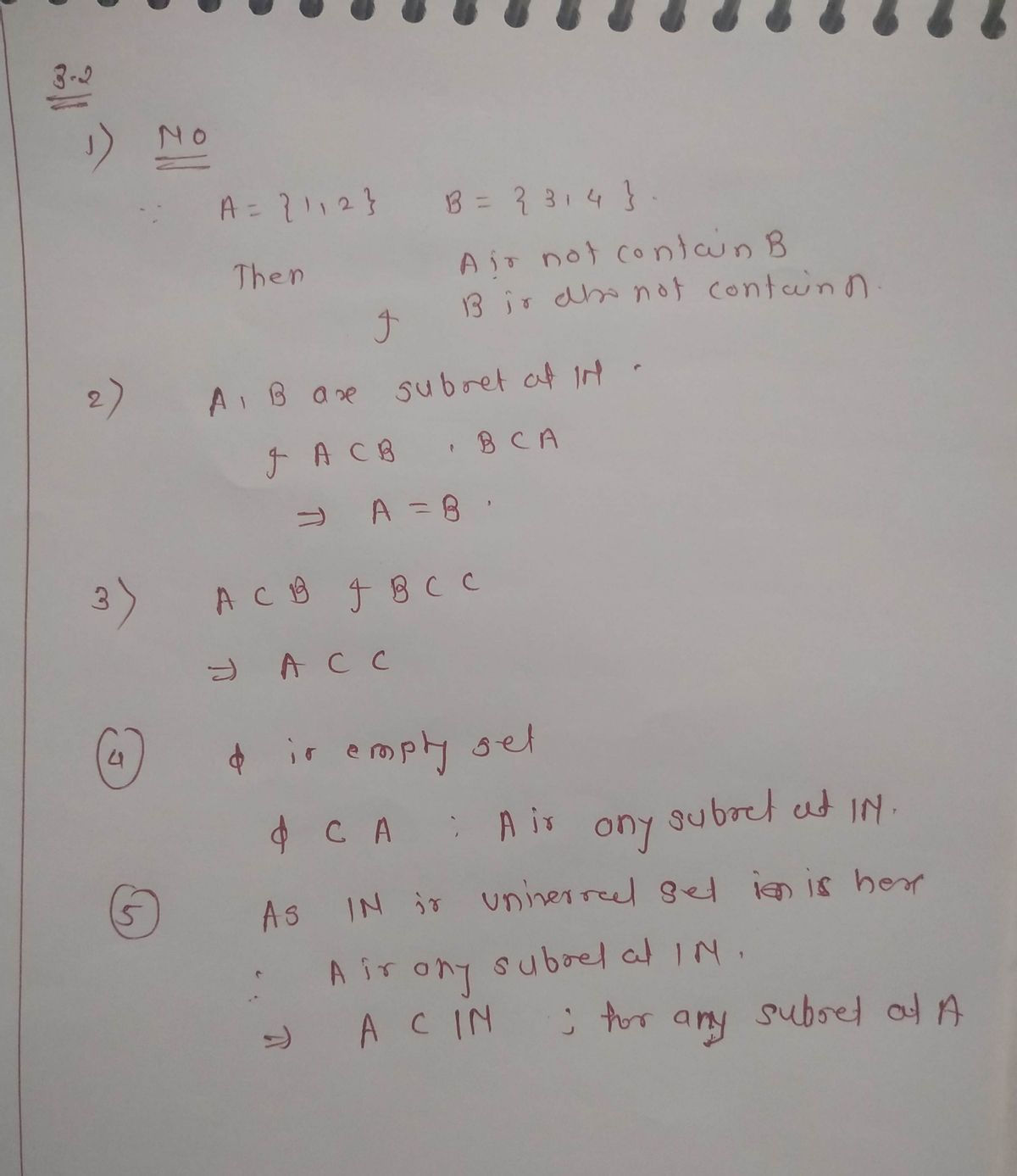Exercise 3.2. Consider the relation "is a subset of" symbolized C on the collection of all subsets of N. Rather than write ({1,2}, {1, 2, 3}) EC, we write {1,2} C {1,2, 3}. For this relation, determine the answer to each of the following questions: (1) Given A, B subsets of N, are they always related by C? (2) Given A, B subsets of N, is it possible that both A C B and B C A? (3) Given A, B,C subsets of N, if A C B and BCC, what may we conclude? (4) How does Ø stand in the relation? (5) How does N stands in the relation?
Exercise 3.2. Consider the relation "is a subset of" symbolized C on the collection of all subsets of N. Rather than write ({1,2}, {1, 2, 3}) EC, we write {1,2} C {1,2, 3}. For this relation, determine the answer to each of the following questions: (1) Given A, B subsets of N, are they always related by C? (2) Given A, B subsets of N, is it possible that both A C B and B C A? (3) Given A, B,C subsets of N, if A C B and BCC, what may we conclude? (4) How does Ø stand in the relation? (5) How does N stands in the relation?
Advanced Engineering Mathematics
10th Edition
ISBN:9780470458365
Author:Erwin Kreyszig
Publisher:Erwin Kreyszig
Chapter2: Second-order Linear Odes
Section: Chapter Questions
Problem 1RQ
Related questions
Concept explainers
Equations and Inequations
Equations and inequalities describe the relationship between two mathematical expressions.
Linear Functions
A linear function can just be a constant, or it can be the constant multiplied with the variable like x or y. If the variables are of the form, x2, x1/2 or y2 it is not linear. The exponent over the variables should always be 1.
Question
Solve Exercise 3.2 all the parts in details please

Transcribed Image Text:3.1. Linear Order. Our goal is to define a topology on a set induced by an order on that
set. But first we have to make clear what we mean by "order" on a set.
Definition 3.1. Let X be a set. A relation R on X is a set of ordered pairs from X x X.
For x, y E X, rather than write (x, y) E R, we usually write xRy, putting the symbol of the
relation between x and y.
Exercise 3.2. Consider the relation "is a subset of" symbolized C on the collection of all
subsets of N. Rather than write ({1,2}, {1, 2, 3}) eC, we write {1,2} C {1,2, 3}. For this
relation, determine the answer to each of the following questions:
(1) Given A, B subsets of N, are they always related by C?
(2) Given A, B subsets of N, is it possible that both A C B and B C A?
(3) Given A, В,С subsets of N, if A c В аnd B c C, what may we coпcude?
(4) How does Ø stand in the relation?
(5) How does N stands in the relation?
3.1.1. Linear Orders. Certain types of relations have served important roles in analysis.
Among them are orders, and we shall first study linear orders. A nondegenerate set is a set
with more than one element.
Definition 3.3. Let X be a set and < a relation on X. We say < is a linear order iff it
satisfies the following axioms:
(1) Antireflexive: Vx E X,¬(x < x).
(2) Comparable: V different x, y E X, x < y V y < x.
(3) Transitive: V different x, y, z E X, (x < y ^ y < z) → x < z.
A set with a linear order is a pair (X,<). When we say X is a linearly ordered set, we
understand a particular linear order < on X. When we say X is an ordered set we usually
mean X is a linearly ordered set.
Remark 3.4. Given a set X and linear order <, for convenience we write a < b as shorthand
for a < b V a = b. The reader should be able to figure out the standard meaning of > and
>.
Remark 3.5. The natural order on the natural numbers N, conveniently symbolized by
<, is a linear order. The natural order on the real numbers R is also a linear order. These
examples motivate the definition above.
Exercise 3.6. Prove that a linear order is antisymmetric: V different x, y E X,¬(x <
y ^y < x).
Problem 3.7. Why is C not a linear order on the collection of subsets of N? Which
ахiотs fail? ‑
Exercise 3.8. Let X be a set with linear order <. Let Y C X. Show that < induces a
linear order on Y. (Define it
compare "restricting" a function to a subset of its domain.)
Expert Solution
Step 1

Trending now
This is a popular solution!
Step by step
Solved in 2 steps with 2 images

Knowledge Booster
Learn more about
Need a deep-dive on the concept behind this application? Look no further. Learn more about this topic, advanced-math and related others by exploring similar questions and additional content below.Recommended textbooks for you

Advanced Engineering Mathematics
Advanced Math
ISBN:
9780470458365
Author:
Erwin Kreyszig
Publisher:
Wiley, John & Sons, Incorporated

Numerical Methods for Engineers
Advanced Math
ISBN:
9780073397924
Author:
Steven C. Chapra Dr., Raymond P. Canale
Publisher:
McGraw-Hill Education

Introductory Mathematics for Engineering Applicat…
Advanced Math
ISBN:
9781118141809
Author:
Nathan Klingbeil
Publisher:
WILEY

Advanced Engineering Mathematics
Advanced Math
ISBN:
9780470458365
Author:
Erwin Kreyszig
Publisher:
Wiley, John & Sons, Incorporated

Numerical Methods for Engineers
Advanced Math
ISBN:
9780073397924
Author:
Steven C. Chapra Dr., Raymond P. Canale
Publisher:
McGraw-Hill Education

Introductory Mathematics for Engineering Applicat…
Advanced Math
ISBN:
9781118141809
Author:
Nathan Klingbeil
Publisher:
WILEY

Mathematics For Machine Technology
Advanced Math
ISBN:
9781337798310
Author:
Peterson, John.
Publisher:
Cengage Learning,

